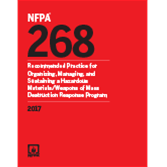Click here to purchase
Build, convert, test, and maintain marine fire-fighting vessels for effective operation with the 2013 NFPA 1925.
NFPA 1925: Standard on Marine Fire-Fighting Vessels details requirements for the construction of new marine fire-fighting vessels and the conversion of existing vessels for fire-fighting purposes. It also details the minimum testing and maintenance requirements for marine fire-fighting vessels.
The Standard defines five classes of fire-fighting vessels and specifies:
- Design considerations
- Classifications
- Fire-fighting system capabilities
- Foam systems
- Owner responsibilities
- Fire protection equipment for the vessel
- Fire-fighting and emergency equipment for the vessel
- Subdivision and stability criteria
- Main propulsion and auxiliary systems
- Auxiliary machinery and systems
- Electrical systems
- Outfitting
- Communications and equipment
- Navigation systems and equipment
- Protective coatings and corrosion protection
- Tests and trials
- Vessel maintenance
Changes in the 2013 NFPA 1925 include new definitions.
Updates include new definitions for Category A, Machinery Space of Category A, and Net Positive Suction Head (NPSH) (hsw), plus a revised definition for Fire-Fighting Vessel. NFPA 1925 also reflects vessel classifications and capabilities consistent with the NIMS DHS, focused on upgraded pumping capacity and identified fire-fighting equipment. It’s an essential resource for AHJs, local fire authorities, purchasers, and manufacturers of fire-fighting vessels. NFPA 1925 is not a detailed manufacturing purchase specification, but rather a reference for the minimum requirements that should be included within a purchase specification.
Product Details
- Published:
- 12/17/2013
- ISBN(s):
- 9781455906055
- Number of Pages:
- 54


